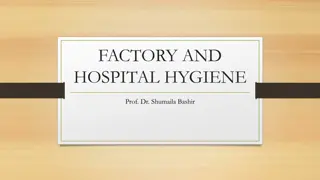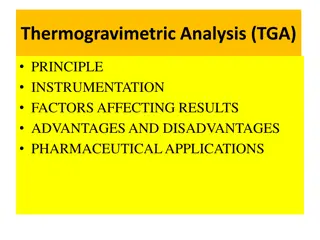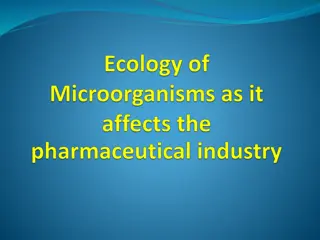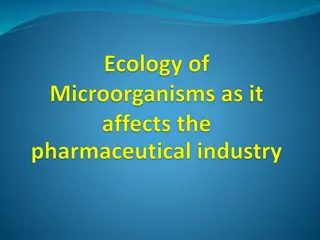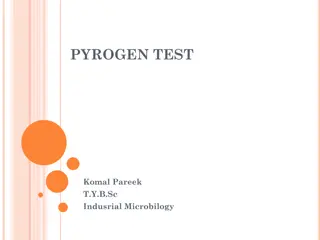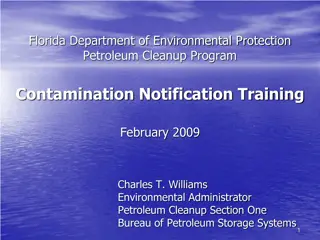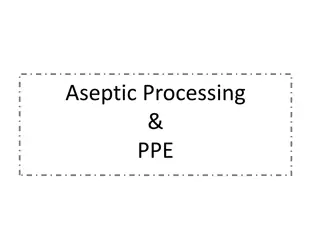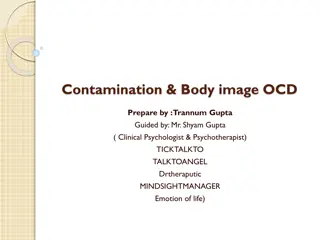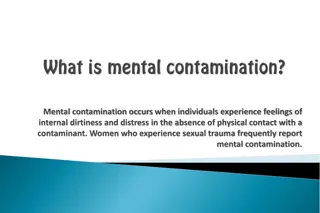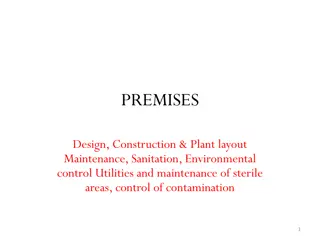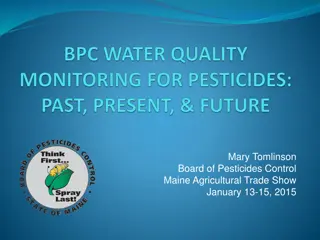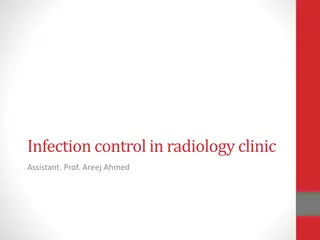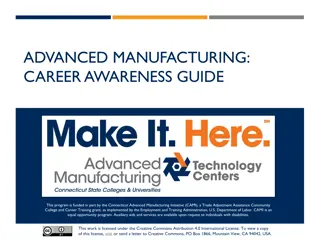Best Practices for Contamination Control in Pharmaceutical Manufacturing
Implementing a robust Contamination Control Strategy (CCS) as part of the Pharmaceutical Quality System is crucial for ensuring product quality and safety. The strategy encompasses various elements like process risk management, preventative maintenance, and personnel training. Manufacturers must focus on sterility assurance without solely relying on final product tests. Proper transfer of equipment and materials, along with stringent cleaning procedures, is essential to prevent contamination risks.
Download Presentation

Please find below an Image/Link to download the presentation.
The content on the website is provided AS IS for your information and personal use only. It may not be sold, licensed, or shared on other websites without obtaining consent from the author.If you encounter any issues during the download, it is possible that the publisher has removed the file from their server.
You are allowed to download the files provided on this website for personal or commercial use, subject to the condition that they are used lawfully. All files are the property of their respective owners.
The content on the website is provided AS IS for your information and personal use only. It may not be sold, licensed, or shared on other websites without obtaining consent from the author.
E N D
Presentation Transcript
Annex 1 Round table discussions 32nd NKRV Workshop June 30, 2023 Nijmegen
Eudralex Volume 4 Annex 1: Principles A Contamination Control Strategy (CCS) should be implemented across the facility in order to define all critical control points and assess the effectiveness of all the controls (design, procedural, technical and organisational) and monitoring measures employed to manage risks to medicinal product quality and safety. The combined strategy of the CCS should establish robust assurance of contamination prevention. The CCS should be actively reviewed and, where appropriate, updated and should drive continual improvement of the manufacturing and control methods. Its effectiveness should form part of the periodic management review. Where existing control systems are in place and are appropriately managed, these may not require replacement but should be referenced in the CCS and the associated interactions between systems should be understood.
Contamination Control Strategy (CCS) as part of the Pharmaceutical Quality System (PQS) Design of the plant and processses Raw material controls Process risk management Preventative maintenance Product containers and closures Process validation Cleaning and disinfection Premises and equipment Validation of sterilisation processes Monitoring systems Personnel Vendor approval Preventative mechanisms (trend analysis, RCA etc.) Utilities Management of outsourced activities Continuous improvement based on information derived from the above
The manufacturer should take all steps and precautions necessary to assure the sterility of the products manufactured within its facilities. Sole reliance for sterility or other quality aspects should not be placed on any terminal process or finished product test.
Transfer of equipment and materials No sterilization possible risk-assessment One of the greatest potential sources of contamination Introduction and removal via a unidirectional process (for grade A and B areas) Airlocks for physical separation Separation of MAL and PAL time- based Validate and implement procedure achieving similar objective (e.g. using an effective transfer disinfection process or rapid transfer systems for isolators) Approved list of materials assessed during validation of transfer process (A/B isolator: protection required when transitioning grade B) Transfer of lower grade to higher grade subject to cleaning and disinfection
Decontamination methods For isolators: The bio-decontamination process of the interior should be automated, validated and controlled within defined cycle parameters and should include a sporicidal agent in a suitable form (e.g. gaseous or vaporized form). For Restricted Access Barrier Systems (RABS): The sporicidal disinfection should include the routine application of a sporicidal agent using a method that has been validated and demonstrated to robustly include all areas of the interior surfaces and ensure a suitable environment for aseptic processing.
Disinfection More than one type of disinfecting agent should be employed Disinfection should include the periodic use of a sporicidal agent Monitoring to assess the effectiveness and to detect changes in types of microbial flora Prior cleaning to remove surface contamination should be performed Cleaning programmes should effectively remove disinfectant residues Their combined usage is effective against bacteria and fungi e.g. organisms resistant to the disinfection regime currently in use The cleaning process and disinfecting agents should be validated to be able to: Remove any residue or debris that would detrimentally impact the effectiveness of the disinfecting agent used Minimize chemical, microbial and particulate contamination of the product during the process and prior to disinfection
Potential challenges specifically related to radiopharmaceutical production (1) Very comprehensive list of approved materials for radiopharmaceutical production Cleaning and disinfection of sterile, individually packaged materials Integrity of outer package? Preparation of production bag for each radiopharmaceutical Use of tools to create distance (e.g. tongs, transportcarts) UMCG SPECT facility: No physical separation of MAL/PAL Use of a sporicidal agent for LAF cabinets/Hotcells Long incubation time required for sporicidal effect Residue difficult to remove Potential damage to synthesis modules
Air pressure and -flow Critical air pressure differences Continuous monitoring required Visualization of airflow patterns within cleanrooms and zones Unidirectional flow Cleanroom classification should be carried out in the at rest and in operation states and regularly requalified (A & B areas: every 6 months, C & D areas: every 12 months). Requalification includes cleanroom classification (total particle concentration), integrity test of final filters, airflow volume measurement, verification of air pressure difference between rooms, air velocity test
Potential challenges specifically related to radiopharmaceutical production (2) Air pressure differences according to KEW and GMP are conflicting Undirectional airflow within LAF cabinet/hotcells can be challenging due to extensive setup of synthesis modules/dispensing methods Smoke tests
Personnel The personnel accessing grade A and B areas should be trained for aseptic gowning and aseptic behaviours Only the minimum number of personnel required should be present in cleanrooms All personnel should receive regular training, gowning qualification and assessment in disciplines relevant to the correct manufacture of sterile products Compliance with aseptic gowning procedures should be confirmed by assessment and periodic reassessment at least annually Aseptic operations should be observed by personnel with specific expertise in aseptic processing on a regular basis Involves both visual and microbial assessment (using monitoring locations such as gloved fingers, forearms, chest and hood (facemask / forehead)
Gowning procedure Outdoor clothing including socks (other than personal underwear) should not be brought into changing rooms leading directly to grade B and C areas Single or two-piece facility trouser suits, covering the full length of the arms and the legs, and facility socks covering the feet, should be worn before entry to change rooms for grades B and C Facility suits and socks should not present a risk of contamination to the gowning area or processes
Potential challenges specifically related to radiopharmaceutical production (3) No extra personnel airlock present at UMCG facility Most personnel has a background in chemistry limited experience with aseptic preparations
Aseptic preparations filtration Solutions or liquids should be sterilized by filtration (max. pore size of 0.22 m) and subsequently aseptically filled into a previously sterilised container The integrity of the sterilised filter assembly should be verified by integrity testing before use (pre-use post sterilisation integrity test or PUPSIT) Risk analysis
Single use systems (SUS) There are some specific risks associated with SUS which should be assessed as part of the CCS. These risks include but are not limited to: The interaction between the product and product contact surface (such as adsorption, or leachables and extractables) The fragile nature of the system compared with fixed reusable systems The increase in the number and complexity of manual operations (including inspection and handling of the system) and connections made The complexity of the assembly The performance of the pre- and post-use integrity testing for sterilising grade filters The risk of holes and leakage The potential for compromising the system at the point of opening the outer packaging The risk of particle contamination Critical manual handling operations of SUS such as assembly and connections should be subject to appropriate controls and verified during APS
Potential challenges specifically related to radiopharmaceutical production (4) Sterilization at 121 C is generally not possible Use of many SUS Inventarisation of risks required within CCS PUPSIT not possible for single use filters Risk analysis/validation required
Aseptic process simulation (APS) Media fill The target should be zero growth Any contaminated unit should result in a failed APS and the following actions should be taken: An investigation to determine the most probable root cause(s) Determination and implementation of appropriate corrective measures
Environmental & process monitoring Microorganisms detected in the grade A and grade B areas should be identified to species level and the potential impact of such microorganisms on product quality (for each batch implicated) and overall state of control should be evaluated.
Potential challenges specifically related to radiopharmaceutical production (5) Assembly for radiopharmaceutical production in LAF cabinet (grade A in C background) Extensive setup of synthesis modules/dispensing methods Difficulties with unidirectional flow Grade A/B isolators for 89Zr-radiopharmaceutical production Many manipulations (room for optimisation). Suboptimal air pressure differences due to KEW (nuclear energy law) Many single use systems (SUS), materials and distance tools Difficult to validate decontamination/cleaning




